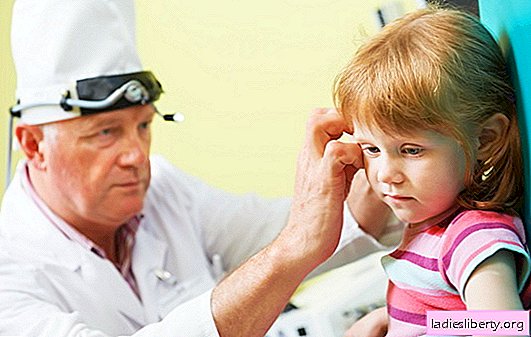
Inflammation of the middle ear is a dangerous disease.
In addition to severe pain, fever, hearing loss, serious complications can develop.
The drum cavity is connected with the brain, its membranes, so untimely or improper treatment can lead to encephalitis, meningitis, damage to the facial nerve.
Otitis media is often found in childhood.
According to studies, almost 90% of children under the age of 2 years have had this disease. This pattern is easily explained. There is a blame for everything anatomical structural features. The child has an auditory tube that connects the tympanic cavity and nasopharynx, wide and short, located horizontally. Because mucus, bacteria easily enter the middle ear.
After a common cold, sore throat, sinusitis, symptoms of otitis may be observed. Local factors of immune defense are not fully formed, because the minimum number of microbes in a child causes inflammation.
Otitis media: the spread of infection
Infection with otitis media can get into the tympanic cavity in several ways:
• Tubogenic. The Eustachian tube opens into the nasopharynx, all inflammatory processes that are observed in the oral cavity, pharynx, larynx, sinuses, can cause otitis media. About 85% of the infection has just this pathway.
• Hematogenous. The middle ear is well supplied with blood, along with the blood stream viruses, bacteria are often introduced, for example, with flu, rubella, scarlet fever.
• Through the eardrum. With traumatic injury, all pathogenic microorganisms freely enter the middle ear, causing inflammation.
• Retrograde path is very rare. This term means that an infection from the cavity of the skull, brain, and membranes descends into the tympanic cavity.
Causes of otitis media
The directly etiological cause of the disease is microorganisms:
• Among bacteria, otitis media causes pneumococcus (Streptococcus pneumoniae), hemophilus bacillus (Haemophilus influenzae), moraxella (Moraxella catarrhalis). In 95% of cases, these bacteria are seeded with laboratory diagnosis. It is extremely rare that pathogens have pyogenic streptococcus, Staphylococcus aureus, mycoplasma, chlamydia.
• In 10% of cases, the cause is influenza viruses, parainfluenza, adenovirus, respiratory syncytial virus.
Also provoking factors include:
• Allergic diseases. When an allergen enters the body, swelling of the mucous membrane occurs, the lumen of the Eustachian tube narrows, the contents of the tympanic cavity are not fully excreted, otitis media of the middle ear develops due to stagnation. Because bronchial asthma, urticaria, food allergies require increased attention.
• Sore throat, pharyngitis, laryngitis, diseases of the teeth, mouth, sinuses, frequent runny nose increase the risk of inflammation.
• Diseases that are accompanied by a decrease in immunity adversely affect the protection factors of the middle ear. Therefore, with diabetes, kidney, liver, viral diseases, hypothermia, otitis media occurs more often.
• Due to coughing, sneezing, blowing your nose, the pressure in the nasopharynx rises, which is accompanied by the injection of infected mucus into the tube.
Otitis media: developmental mechanism
In a healthy person, a small amount of mucus is located in the tympanic cavity, which flows freely into the nasopharynx.
When conditionally pathogenic microbes get in, they do not cause changes, since local immunity cells destroy bacteria. If one of the above factors is present, normal drainage of the middle ear ceases. The tube becomes edematous, the lumen narrows or even closes. Liquid accumulates in the tympanic cavity, after some time microbes begin to multiply. The amount of mucus increases, it presses on the membrane, causing pain, throbbing.
The process can develop into purulent. Then a breakthrough occurs, and all the contents come out through the auditory opening.
Otitis media. How to recognize a disease?
Adults often complain of pain in the ear. But how to suspect otitis media in a child up to a yearwhen he doesn’t know how to talk and doesn’t tell you where it hurts? Attention should be paid to additional manifestations.
• Pain sensations are of a different nature. Some people will note dull pain, others - acute, pressing, throbbing. It all depends on the stage of the process, structural features. It intensifies at night, in the morning.
• In acute otitis media of the middle ear, a small child is restless, sleeps poorly, reaches with his arms to the ear. If you try to touch the painful area, it will begin to cry, in every way preventing your attempts.
• On the side of the lesion, hearing is reduced, an adult can notice this on his own. The mother of the baby should pay attention to whether he hears the same on both sides. To do this, it is worth calling the child to himself, first to the right, then to the left of him. Perhaps, in some cases, the baby’s reaction will be late, or he will not respond.
• An increase in body temperature is a characteristic feature of otitis media.
• Intoxication syndrome attracts attention: headache, weakness, loss of appetite, constant fatigue. In a child, this is manifested by a rejection of the chest, unwillingness to play, lethargy, and increased drowsiness.
• Infants may have vomiting, diarrhea.
• When an eardrum breaks, pus escapes from the ear. This is an important symptom that indicates acute otitis media of the middle ear.
Otitis media. Diagnostic Methods
Clinically, it is difficult to make a diagnosis, since similar symptoms are observed with other diseases. A foreign body entering the ear canal is accompanied by pain, hearing loss, but body temperature is within normal limits. When bathing, the ear may become blocked, as there is water. Hearing loss is the main symptom, pain, anxiety, intoxication syndrome is absent.
After collecting complaints, assessing the general condition, the doctor performs the following manipulations:
• Otoscopy. Using a special device, the doctor examines the eardrum. There are signs, based on which, you can make a diagnosis of otitis media. If the disease is mild, slight retraction and hyperemia of the membrane is noted. In severe cases, redness is observed, smoothing of its edges, the liquid level is visible through the membrane itself, which has the shape of an arc. Sometimes you can even determine the color of the exudate.
• But the data of otoscopy are not always unambiguous, tympanometry is used to confirm otitis media - determining the mobility of the eardrum. In the inflammatory process, it is tense, inactive.
• If severe hearing impairment is observed, conduct audiometry.
• Severe general condition, high temperature can lead the doctor to the possibility of complications. In this case, computed or magnetic resonance imaging will help to rule out encephalitis, meningitis.
• It is very rare to puncture the tympanum in order to obtain exudate for research, to determine the pathogen, and sensitivity to antibiotics. This is a serious procedure, it is indicated in severe cases, treatment failure, in children with immunodeficiency.
Common complications of otitis media
Late admission to the hospital can lead to complications. Most of them are dangerous to health, therefore, with the first symptoms of otitis media, you need to consult a doctor.
• Pus accumulates in the tympanic cavity, the membrane becomes thinner, its rupture occurs over time. In this case, the symptoms are reduced, there is a positive dynamics of the general condition.
• The gap is accompanied by a temporary loss of hearing. Fortunately, the defect heals quickly, the recovery process takes from several days to a week.
• With the spread of inflammation to the brain, serious diseases arise: brain abscess, meningitis, encephalitis.
Otitis media. Treatment features
Uncomplicated patients are treated at home, hospitalization in a hospital is indicated for severe cases, suspected meningitis, encephalitis.
Treatment of acute otitis media of the middle ear can be:
Medicated, which includes:
• Antibiotics.
• Antipyretic drugs.
• Vasoconstrictor drugs in the nose.
• Treatment of concomitant pathology.
Surgical, which implies:
• Miringotomy.
• Tympanopuncture.
Antibiotics. Preparations of this group are prescribed for severe forms of otitis media. With a mild course, expectant tactics are possible. First, the patient uses antipyretic, painkillers, if after 2 days there is no improvement, or vice versa, it gets worse, antibiotics are used.
In some cases, they are prescribed immediately, without waiting several days. These situations include:
• A child of the first two years should take antibiotics.
• Pain, intoxication, temperature greatly worsen the condition.
• Both ears are drawn into the pathological process.
The drugs of choice are protected penicillins (Amoxiclav, Augmentin), also cephalosporins. The method of application may be different. Pills are prescribed for adults, and syrups are recommended for children. In order to achieve high efficiency, quick recovery, injectable forms are used.
If the patient is allergic to the penicillin series, cephalopsorins, or they are ineffective, macrolides (clarithromycin, azithromycin), levofloxacin come to the aid of the doctor. After using the drugs, side effects can be observed: diarrhea, nausea, headache, allergic rash.
Antipyretic. These remedies also have painkillers. At the moment, 2 groups of drugs are recommended for the treatment of otitis media: paracetamol and ibuprofen. They are allowed to children.
Vasoconstrictor. This is not the main direction in the treatment of otitis media. Often a chronic runny nose provokes an inflammatory reaction in the ear. After treatment of rhinitis, the risk of a disease is reduced significantly.
Particular attention should be paid to foci of chronic infection. Tonsillitis, pharyngitis, sinusitis are the cause of otitis media. Timely treatment this pathology has a positive effect on the course of the disease.
Myringotomy. This surgical intervention is necessary in case of a serious condition of the patient, with the ineffectiveness of conservative therapy, to alleviate the symptoms. After anesthesia, an incision is made in the eardrum, through which pus flows. As a result, pain, intoxication subside. Also, the fluid is taken for further research, determining the pathogen, sensitivity to antibiotics.
Tympanopuncture performed both for the purpose of diagnosis and treatment. After infiltration anesthesia with a special needle, a puncture is made in the posterior lower square of the eardrum. Through this hole, the contents are pumped out by suction.











